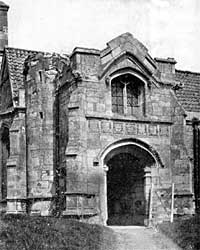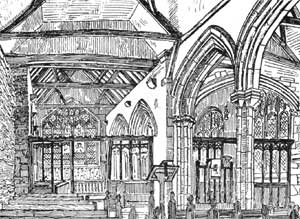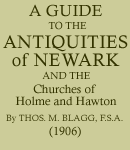< Previous | Contents | Next >

The porch, Holme church.
The room over the porch, an uncommon feature in a tiny village church, is known as "Nan Scott's Chamber," from the legend that an old woman named Ann Scott made it her dwelling during the time that Holme was visited by the plague in the seventeenth century. It contains an ancient chest with a coped lid, much dilapidated, possibly of the fifteenth century.
The bells are three in number and of some interest.
No. 1 has the founder's mark of Henry Oldfield, of Nottingham, and bears the date 1592, and the legend "RAVFE BARTOVN ES QVTER DID GIVE THIS BELL."
No. 2, the oldest, appears to be of fifteenth century workmanship, and has only its name, T O B I A S, in single Lombardic capitals.
No. 3 is a Commonwealth bell, with the founder's mark of George Oldfield, and the date 1657, legend "GOD SAVE THE CHVRCH."
The fifteenth century bench ends should be noticed— eagles, lions, talbots, chameleons, and cherubim being figured. The stained glass is of much interest, though it is fragmentary and inserted with no regard for its proper position; for instance, there is part of a figure of a bishop in the north-east window of the chancel, represented in chasuble and dalmatic, but it is upside down. Everywhere, in glass and stone, is scattered the initial "B" of Barton, their rebus of a tun, and their merchant's mark.

Holme church, interior.
The details of stonework in the Barton chapel are worthy of notice. In the south wall is a beautiful piscina, with flower-formed drain, the holes pierced at the junction of the petals; over the arched recess is a crocketed ogee hood mould; the flanking pinnacles and the finial are gone. On either side of the east window are canopied niches; projecting from the underside of the northernmost is a figure of a deacon in a dalmatic, holding a chalice. Above the eastern arch is a bust of the Devil. The Tudor rose is a distinctive feature in the ornament.
The Barton estates here passed by marriage to the family of Bellasis, of whom was the gallant Governor of Newark during its last siege. On the floor of the Barton Chapel is a slab inscribed :—
Here lie interred ye Body of
John Belasys of Holme in the
County of Nottingham, Esquire,
And of Catherine his wife. Catherine
Dyed the 10th of March, 1716, and
Mr. Belasyse the 10th of Aprill, 1717.
Requiescant in Pace.
The only other inscription in the church is a brass plate in the north aisle of the nave to John Randolph, son of the Rev. Randolph Marriott and Ann, his wife, who died of the typhus fever, March 6th, 1812, at Newark, in the fourteenth year of his age.
The original roof of the church has disappeared, though the corbels which support it remain. The line of the original depressed roof of the south aisle may be seen from the outside at the west end.
Outside the church a carved rose, with leaves and stem, should be noticed beneath the parapet of the south aisle, and near it a "coward" heraldic lion, with its tail passed between its legs.
First to catch the eye on entering the churchyard gate are the seven shields of arms across the front of the porch. They are—
1. Barton and Ratcliffe quarterly, impaling quarterly Assheton and Leigh. The letters R and B are cut on either side of this shield, and below it two sprigs of oak.
2. Stanhope (borne also by Longvilliers) impaling Molineux, with the letters I and S on either side.
3. On a fesse between three bucks' heads cabossed, a mullet. The letters I and B on either side, a sprig of oak and a dolphin embowed; below it the rebus, two bears with tuns.
4. The arms of the Merchants of the Staple of Calais, with on one side a falcon perched, on the other two dolphins embowed, and below two sheep.
5. A merchant's mark, with the letters I and B on either side below two bales of wool, each bearing three estoiles of six points in fesse.
6. Barton impaling Bingham, with the letters I and B on either side.
7. Barton impaling six pieces, one and four Ratcliffe, two and five Leigh, three and six Assheton; with the letters B and B on either side and two sprigs of oak below.
On one of the buttresses of the tower, and on either side of the west window, the arms of the staple merchants and the merchant's mark on shield 5 again occur. Similar shields are on the buttresses of North Muskham church on the opposite bank of the Trent.
In the porch will be noticed a holy water stoup with panelled sides. The old bier hangs on the wall inside the tower.
The present parish registers do not begin until 1711, though when Dickinson wrote, a hundred years ago, they were extant from 1569. Some transcripts of the seventeenth century remain among the muniments at Southwell, and were printed by The Thoroton Society (Record Scries, Vol. I.) in 1903.
The plate consists of a cup and paten of about the year 1700.
In the village, at the approach to the ancient ferry, is the stump of a wayside Cross; on Trent's opposite bank, at North Muskham, is its fellow, with most of its shaft remaining, standing at the entrance to the grassy lane which once led to the water, and a few yards from the other end of which can still be seen the tiny artificial basin or "staithe," now dry and grassy, where the mediaeval ferry-boat landed its passenger after he had commended himself to God at the Holme Cross, before venturing the "perils" of the waters.
